One Festival of Homeless Arts brings together works of visual art, theatre, film and photography, all created by artists who are or have been homeless.
The work is being exhibited at the Old Diorama Arts Centre in London.
Three festival artists talk about their work and how their art relates to their experiences of homelessness.
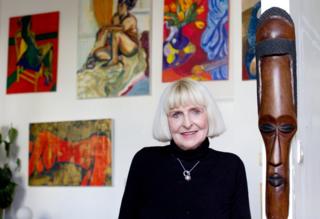
Geraldine Crimmins, from London, discovered her love of art when in prison at the age of 50 as a result of her drug addiction. “I got arrested and it was great because I got detoxed,” she says. “Prison was brilliant, it got my head clear, I cleaned up in there. It saved my life.”
Previously, Geraldine was a businesswoman but says her mental health deteriorated in her late 30s. She lost two businesses and her house to drug addiction by the time she was 40.
She has experienced homelessness, spending two years on the streets around Victoria station in London. When she was mugged, she spent six weeks in hospital and then moved to bed and breakfast accommodation, where she spent a further four years. She now lives in north London.
While in prison, Geraldine attended an art class and started to paint portraits of nude figures. “I’ve always liked the female nude. I’ve developed my artistic eye and I do more abstract figurative work now.”

She submitted a small watercolour painting of a nude to a prison exhibition. Six people wanted to buy the painting. “That gave me such a buzz when I sold it. At the exhibition the next year I sold two more pieces.”
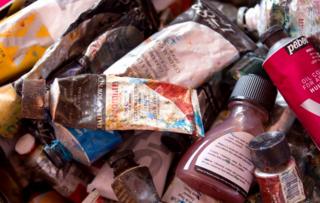
Geraldine is now an art mentor for people with mental health difficulties who have been in a hostel or living on the street.
She also takes a women’s group to the Royal Academy of Arts every two months to see an art exhibition. “There are so few things for women in the homeless arena, I try to give women a voice.
“I’ve been diagnosed with PTSD and an anxiety disorder, and I got treatment.
“But I think a lot of mental health conditions of the homeless go untreated. Many homeless people don’t realise that they actually need to see a psychiatrist or clinical psychologist.”


As a self-employed artist, Geraldine carries out consultancy work for Cafe Art, a social enterprise that aims to empower people affected by homelessness by supporting their art, photography and entrepreneurship.
“Someone once asked me what my dream would be and I said working with marginalised people and being an artist, [which has] ended up coming around. It’s been amazing.”
Geraldine has submitted a number of paintings to this year’s festival, including the image below called Woman with Purple Hair, drawing inspiration from a book of nude photo portraits.
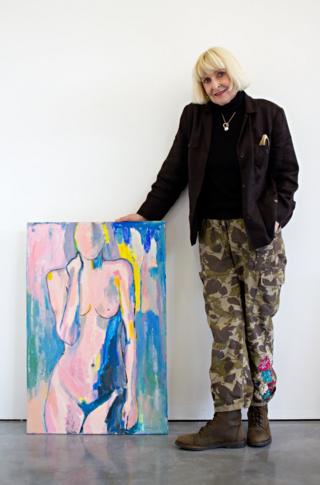
One Festival of Homeless Arts was founded in 2016 by ex-homeless artist and campaigner David Tovey, seen below with one of his works during the hanging of the exhibition.
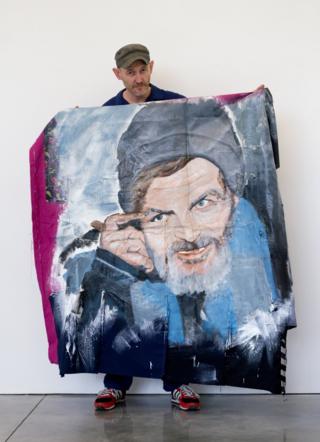
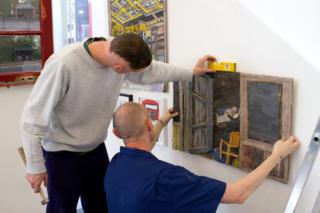
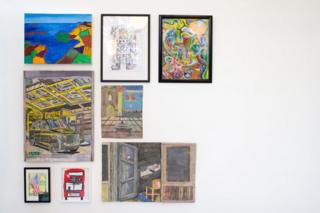
Artist Stephen O’Grady submitted three pieces of art to the festival, seen below.
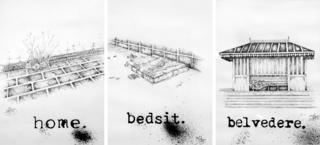
The ink drawings show different places in which a homeless person may find themselves sleeping: a pavement, on a discarded mattress or in a seaside shelter.
“I’ve slept on mattresses I’ve found so many times,” Stephen says. “To someone that’s a discarded bit of rubbish, but at that time that was home to me. I’m trying to get that across in the art – that everything has a value to somebody.”
Stephen found himself homeless in late 2015, following several years of alcohol abuse and the breakdown of his marriage.
He was homeless in Watford, the area in which he grew up, before deciding to travel to the south coast. “If you’re going to be homeless, it’s nice to be beside the seaside, so I went to Brighton.”

The shelter seen in his work, next to the word Belvedere, is a scene from Brighton seafront.
While homeless, Stephen returned to his love of art, which began when he attended Watford School of Art as a teenager.

“I always drew even when I was on the streets, I’d have my sketchpad and pens in my bag. The output wasn’t great.
“But looking back on some of the art is quite eye-opening. It was a diary, like an outlet.”
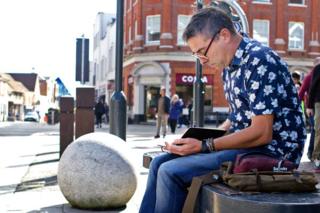
Stephen found creative inspiration from the people around him. “I’m inspired by people’s faces, expressions and speed of movement.
“When you’re homeless you’ve got the freedom to stare a bit more at people, because you are being ignored, plus you’ve nothing else to look at. Not being looked at really got to me.”
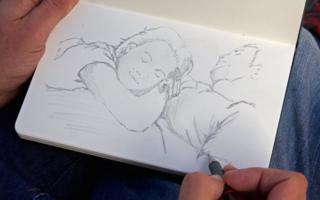
Stephen is now in accommodation in Watford and is nourishing his love of art. “I like the feeling of opening a box of paints, or my art box, and just attacking a bit of paper.”

He recently filled a sketchbook with drawings dedicated to his partner, with every page inspired by her. “She got a feeling of joy when she was given it, saying, ‘No-one’s ever done anything like that for me, that’s amazing.'”
Artist Claire Bastow first experienced homelessness shortly after she moved to London in the 1980s.

“The landlord of the accommodation I was in found out that two of my housemates were gay, and so threw all six of us out,” she says. “I had to sleep on people’s couches. I ended up in a squat for a while. There was no legislation to protect us at that point.”
Later in life, Claire says she was made homeless again as a result of domestic violence.
“When I’ve experienced homelessness it’s been pretty awful, that uncertainty. I’ve had to spend the odd night on the street. Or living on people’s couches.
“I’ve been able to use some of that experience to inspire me creatively. There’ve been some positives from it, that’s how I’ve processed it. All that comes out in my art; a sense of belonging, and not belonging.”
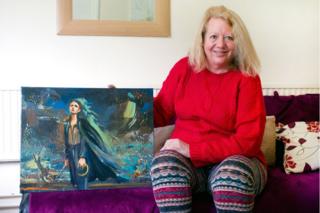
Claire developed her art skills in her late 30s, earning various qualifications, including A-level art. She has fond childhood memories of spending time with her grandfather Basil Bastow, an established watercolour artist who was also president of the Nottingham Arts Council.
“We used to go to art galleries all the time. We queued up for three hours to see the Turner exhibition. Turner was his main inspiration.”
Claire has two portraits in the art festival, both paintings of women who have experienced homelessness, Marianne (below left) and Maiya (below right).
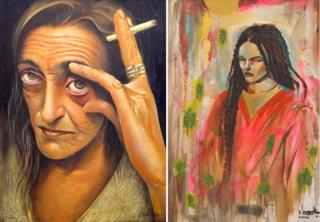
“You can see their stories in the characters of their faces. Marianne is pointing to her eye as though to say, ‘Look at me, I have a story to tell.'”
“When people see my work I hope they get from it the idea that when you first glance at somebody, whoever they are, it’s better to look further. Everyone has got a story.
“Everyone has experienced difficulties in their life. Everyone is valid and has a voice and deserves to be seen and heard, and not hidden away, or stigmatised.”
Artwork in the One Festival of Homeless Arts can be seen at the Old Diorama Arts Centre.
Interviews and photographs by Matthew Tucker.
